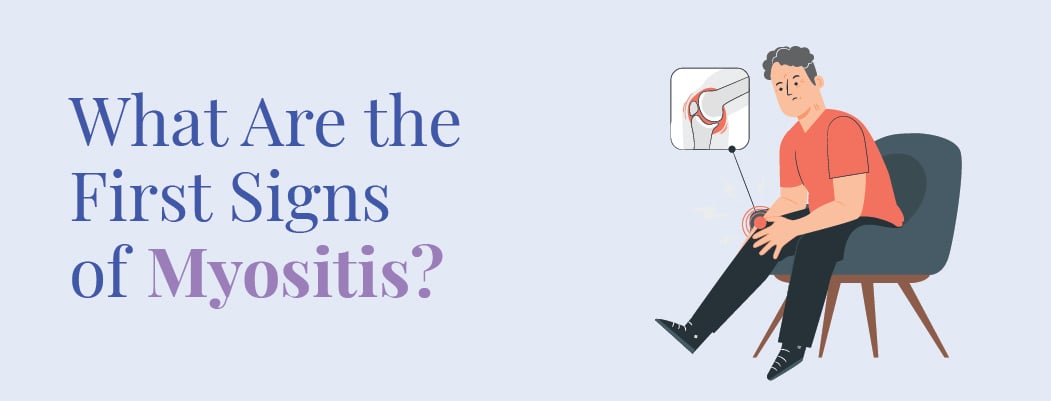Myositis: Symptoms and Causes
April 7, 2023

Myositis: Symptoms and Causes
What is Myositis?
Myositis is a rare autoimmune disease that causes inflammation in the muscles, leading to muscle weakness, pain, and fatigue. There are several types of myositis, and the symptoms and causes may vary from person to person.
Types of Myositis
- Polymyositis:
Polymyositis affects multiple muscles simultaneously, usually those in the center of your body. It develops gradually over time and commonly affects adults, especially women.
Symptoms of polymyositis include difficulty performing everyday movements such as standing up, climbing stairs, lifting objects, and reaching over your head.
- Dermatomyositis
Dermatomyositis is a type of myositis that not only affects your muscles but also your skin. It can develop quickly; early treatment is crucial to avoid severe complications. Anyone can develop dermatomyositis, including children who may have juvenile dermatomyositis.
In rare cases, dermatomyositis can be fatal, especially in the first year after symptoms begin. It can also increase the risk of developing certain types of cancer.
- Inclusion Body Myositis
Inclusion body myositis is a degenerative muscle disease that typically affects people over the age of 50. It causes muscle weakness in the extremities, including the hands and legs below the knees, and can also affect the muscles that help you swallow.
Symptoms of inclusion body myositis include difficulty using your hands and fingers for precise tasks like buttoning a shirt or gripping something small and difficulty walking, standing, and swallowing.
Symptoms of Myositis
The symptoms of myositis can vary depending on the type of myositis a person has. However, some common symptoms of myositis include:
- Muscle weakness: This can occur in any muscle group in the body and is often most noticeable in the arms, legs, and neck.
- Muscle pain can range from mild to severe and can be accompanied by muscle tenderness and swelling.
- Fatigue: People with myositis often feel tired and weak, even after getting plenty of rest.
- Difficulty swallowing: Some people with myositis may have trouble swallowing due to muscle weakness in the throat.
- Skin rash: Dermatomyositis can cause a characteristic facial, neck, and chest rash.
Causes of Myositis
The exact cause of myositis is unknown, but it is believed to be an autoimmune disease. In autoimmune diseases, the body’s immune system mistakenly attacks its own tissues, including muscles. Some factors that may increase a person’s risk of developing myositis include:
- Genetics: Certain genetic mutations may increase a person’s risk of developing myositis.
- Infections: Some infections may trigger myositis in people who are genetically predisposed to the condition.
- Environmental factors: Exposure to certain environmental factors, such as toxins, may increase a person’s risk of developing myositis.
Diagnosis of Myositis
To diagnose myositis, a doctor will perform a physical exam, take a medical history, and may order blood tests, imaging studies, or a muscle biopsy. A muscle biopsy involves removing a small piece of muscle tissue and examining it under a microscope to look for signs of inflammation and damage.
Treatment of Myositis
Treatment for myositis depends on the type and severity of the condition. Some common treatments for myositis include:
- Medications: Experts will prescribe medicines as per your condition.
- Physical therapy: Physical therapy can help improve muscle strength, flexibility, and range of motion.
- Occupational therapy: Occupational therapy can help people with myositis learn new ways to perform daily activities and adapt to muscle weakness.
Prevention of Myositis
There is no surefire way to prevent myositis, but some lifestyle changes may help reduce the risk of developing the condition. These include:
- Maintaining a healthy diet and exercise routine: Regular exercise and a balanced diet can help keep the immune system healthy and reduce the risk of developing autoimmune diseases.
- Avoiding exposure to toxins: Avoiding exposure to toxins, such as pesticides and industrial chemicals, may help reduce the risk of developing myositis.
Who to Consult For Myositis and when?
If you experience any symptoms of myositis, it is important to see a doctor as soon as possible. Your primary care physician may refer you to a rheumatologist or neurologist for further evaluation and treatment.
In addition to seeking medical attention, it is important to talk to your doctor about any medications or supplements you are taking, as some medications and supplements may worsen myositis symptoms.
Myositis can sometimes lead to serious complications, such as difficulty breathing, heart problems, and infections. If you experience any of these symptoms, seek emergency medical attention immediately.
In conclusion, myositis is a rare autoimmune disease that causes inflammation in the muscles, leading to muscle weakness, pain, and fatigue. There are several types of myositis, and the symptoms and causes may vary from person to person. While there is no surefire way to prevent myositis, maintaining a healthy lifestyle and avoiding exposure to toxins may help reduce the risk of developing the condition. If you experience any symptoms of myositis, seek medical attention as soon as possible and talk to your doctor about treatment options.
People also ask
1. What are the first signs of myositis?
It’s important to know the symptoms of myositis, which can include muscle weakness, fatigue, difficulty swallowing or breathing, and joint pain. Your doctor can help you identify the specific symptoms you’re experiencing and how they may relate to myositis.
2. Is myositis a serious condition?
Myositis can be a serious condition, especially if left untreated. It can lead to severe muscle weakness and disability and affect other organs such as the lungs and heart. It’s important to understand the potential complications of myositis and work with your doctor to manage the condition.
3. Can myositis be cured?
Currently, there is no cure for myositis. However, with early diagnosis and treatment, it’s possible to manage the symptoms and prevent further muscle damage. Your doctor can discuss treatment options and help create the best plan for you.
4. Does stress cause myositis?
While stress can exacerbate symptoms, it is not a direct cause of myositis. The exact cause of myositis is not fully understood, but it is believed to be an autoimmune condition, in which the immune system attacks healthy tissues and cells in the body.







